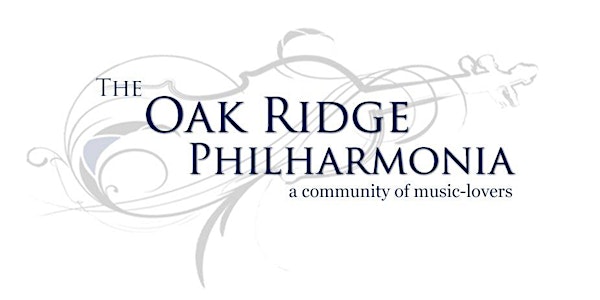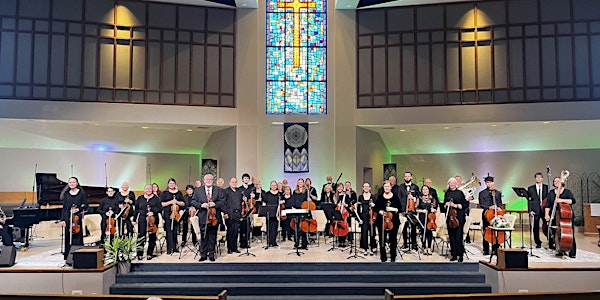

Oak Ridge Philharmonia Spring Concert
The Historic Grove Theater welcomes the Oak Ridge Philharmonia for their spring concert- featuring works by Elgar, Mozart and Tchaikovsky!
Date and time
Location
Historic Grove Theater
123 Randolph Road Oak Ridge, TN 37830About this event
- 1 hour
2024 Spring Concert Features:
- The Pomp and Circumstance Marches (full title Pomp and Circumstance Military Marches), Op. 39, are a series of five (or six) marches for orchestra composed by Sir Edward Elgar. The first four were published between 1901 and 1907, when Elgar was in his forties; the fifth was published in 1930, a few years before his death; and a sixth, compiled posthumously from sketches, was published in 1956 and in 2005–2006. They include some of Elgar's best-known compositions. The title is taken from act 3, scene 3 of Shakespeare's Othello:
Farewell the neighing steed and the shrill trump,
The spirit-stirring drum, th'ear-piercing fife,
The royal banner, and all quality,
Pride, pomp, and circumstance of glorious war!
But also, on the score of the first march, Elgar set as a motto for the whole set of marches a verse from Lord de Tabley's poem "The March of Glory", which begins
Like a proud music that draws men on to die
Madly upon the spears in martial ecstasy,
A measure that sets heaven in all their veins
And iron in their hands.
I hear the Nation march
Beneath her ensign as an eagle's wing;
O'er shield and sheeted targe
The banners of my faith most gaily swing;
Moving to victory with solemn noise,
With worship and with conquest, and the voice of myriads.
March No. 1, was composed in 1901 and dedicated "to my friend Alfred E. Rodewald and the members of the Liverpool Orchestral Society". It had its premiere, along with March No. 2, in Liverpool on 19 October 1901, with Alfred Rodewald conducting the Liverpool Orchestral Society. Elgar and his wife attended, and it was a "frantic" success. The Trio contains the tune known as "Land of Hope and Glory". In 1902 the tune was re-used, in modified form, for the "Land of hope and glory" section of his Coronation Ode for King Edward VII. The words were further modified to fit the original tune, and the result has since become a fixture at the Last Night of the Proms, and an English sporting anthem and general patriotic song.
In Canada, the Philippines, and the United States, the Trio section "Land of Hope and Glory" of March No. 1 is often known simply as "Pomp and Circumstance" or as "The Graduation March" and is played as the processional tune at virtually all high school and most college graduation ceremonies.
- The Piano Concerto No. 14 in E♭ major, K. 449, by Wolfgang Amadeus Mozart was written in 1784. It is the first composition he entered into a notebook of his music that he then kept for the next seven years, marking down main themes, dates of completion, and other important information. From this notebook we have the information that he completed the concerto on February 9, 1784. In the same year, he wrote several concertos in succession, and in a letter to his father that May, wrote of the 15th and 16th concertos that he "could not choose between them" but that "the one in E-flat [No. 14] does not belong at all to the same category. It is one of a quite peculiar kind...". The 14th is regarded as being the first of the mature series of concertos Mozart wrote, and indeed, commentators such as Girdlestone and Hutchings valued it as one of the best, particularly as all three movements are of the highest standard. Mozart wrote this and the piano concertos nos. 12, K. 414, and 13, K. 415, for his subscription concerts, "either with a large orchestra with wind instruments or merely a quattro" [with string quartet].
The concerto has three movements:
Allegro vivace
Andantino
Allegro ma non troppo
Works written in 1784 include, besides this concerto, the five piano concertos 15–19, the Quintet in E♭ for Piano and Winds, and several piano works – the Sonata in C minor being the most noteworthy – one string quartet, and several sets of orchestral dances. Works by other composers who were known to Mozart from around this time include the 80th symphony (in D minor) and second cello concerto of Joseph Haydn. Michael Haydn had published two sets of quartets the year before, and Carl Stamitz and Ignaz Pleyel each wrote another set of six quartets (Pleyel released a further set in 1784.) A Pleyel cello concerto (in C) was also released at some point between 1782–84 (Pleyel being a composer whose quartets, at least, Mozart rated highly.)
- The Symphony No. 5 in E minor, Op. 64 by Pyotr Ilyich Tchaikovsky was composed between May and August 1888 and was first performed in Saint Petersburg at the Mariinsky Theatre on November 17 of that year with Tchaikovsky conducting. It is dedicated to Theodor Avé-Lallemant. In the first ten years after graduating from the Saint Petersburg Conservatory in 1865 Tchaikovsky completed three symphonies. After that he started five more symphony projects, four of which led to a completed symphony premiered during the composer's lifetime. The fifth symphony was composed in 1888, between the Manfred Symphony of 1885 and the sketches for a Symphony in E-flat, which were abandoned in 1892 (apart from recuperating material from its first movement for an Allegro Brillante for piano and orchestra a year later). As for the numbered symphonies, Tchaikovsky's Symphony No. 5 was composed between Symphony No. 4, which had been completed ten years earlier, and Symphony No. 6, composed 5 years later, in the year of the composer's death. Unlike its two predecessors, Symphony No. 5 has no clear program. On 15 April 1888, about a month before he began composing the symphony, the composer sketched a scenario for its first movement in his notebook, containing "... a complete resignation before fate, which is the same as the inscrutable predestination of fate ..." It is however uncertain how much of this program has been realised in the composition. Like the Symphony No. 4, No. 5 is a cyclical symphony, with a recurring main theme. Unlike No. 4, however, the theme is heard in all four movements, a feature Tchaikovsky had first used in the Manfred Symphony, which was completed less than three years before No. 5. Some critics, including Tchaikovsky himself, have considered the ending insincere or even crude. After the second performance, Tchaikovsky wrote, "I have come to the conclusion that it is a failure". Despite this, the symphony has gone on to become one of the composer's most popular works. The second movement, in particular, is considered to be classic Tchaikovsky: well crafted, colorfully orchestrated, and with a memorable melody for solo horn. Possibly for its very clear exposition of the idea of "ultimate victory through strife", the Fifth was very popular during World War II, with many new recordings of the work, and many performances during those years. One of the most notable performances was by the Leningrad Radio Orchestra during the Siege of Leningrad. City leaders had ordered the orchestra to continue its performances to keep the spirits high in the city. On the night of October 20, 1941 they played Tchaikovsky's Symphony No. 5 at the city's Philharmonic Hall and it was broadcast live to London. As the second movement began, bombs started to fall nearby, but the orchestra continued playing until the final note. Since the war it has remained very popular, but has been somewhat eclipsed in popularity by the Fourth and Sixth Symphonies. Critical reaction to the work was mixed, with some enthusiasm in Russia. Valerian Bogdanov-Berezovsky wrote, "The Fifth Symphony is the weakest of Tchaikovsky's symphonies, but nevertheless it is a striking work, taking a prominent place not only among the composer's output but among Russian works in general. ... the entire symphony seems to spring from some dark spiritual experience." On the symphony's first performance in the United States, critical reaction, especially in Boston, was almost unanimously hostile. A reviewer for the Boston Evening Transcript, October 24, 1892, wrote: Of the Fifth Tchaikovsky Symphony one hardly knows what to say ... In the Finale we have all the untamed fury of the Cossack, whetting itself for deeds of atrocity, against all the sterility of the Russian steppes. The furious peroration sounds like nothing so much as a horde of demons struggling in a torrent of brandy, the music growing drunker and drunker. Pandemonium, delirium tremens, raving, and above all, noise worse confounded! The reception in New York was little better. A reviewer for the Musical Courier, March 13, 1889, wrote: In the Tchaikovsky's Fifth Symphony ... one vainly sought for coherency and homogeneousness ... in the last movement, the composer's Calmuck blood got the better of him, and slaughter, dire and bloody, swept across the storm-driven score.
"Farewell, Amanda", written by Cole Porter for the 1949 Spencer Tracy and Katharine Hepburn film Adam's Rib, draws liberally from the 4th movement of Tchaikovsky's 5th Symphony. It is suggested by Ian MacDonald that a fragment of the "fate" theme is quoted by Dmitri Shostakovich in his Symphony No. 7 in the "invasion" theme of the first movement. Part of the second movement was given English lyrics under the title Moon Love and Love Is All That Matters. The beginning of Annie's Song by John Denver is almost identical to the first horn theme in the second movement, but it seems this was unintentional and only pointed out to Denver by his producer Milt Okun. An arrangement of the second movement was used in a prominent 1970s Australian advertisement for Winfield cigarettes.
Frequently asked questions
Yes - thanks to the dedication and generosity of our volunteer musicians and through successful fundraising efforts, the Oak Ridge Philharmonia remains committed to fostering an environment where music remains accessible to all.
Not at all! Seating at the Grove Theater is general admission. Online "pre-registration" simply offers you a way to say - "Count me in! I'm excited to come!"
Check out their website at www.oakridgephilharmonia.org .
Organized by
The Grove Theater in Oak Ridge, TN is a Manhattan Era venue, recently renovated and open for community use.